Petroglyph National Monument protects a sacred, culturally significant site featuring petroglyphs as well as an ancient volcanic landscape. The blending of the history of the site, the desert environment, and the volcanic remains crafts a unique adventure full of learning and appreciation.
 |
| Petroglyphs on a chunky, mocha brown boulder review a little about the ancient history of the Albuquerque area. |
We began our exploration at the Visitor Center. I highly recommend this approach to help orient yourself and choose the correct trails for your day. We were able to learn which trails fit our desired visit goals. Plus, you will have a good opportunity to ask about local flora and fauna as well.
Adventure in the Rocky Landscape of Boca Negra Canyon
We hiked two of the trails at Petroglyph National Monument -- the Boca Negra Canyon trails and the Piedras Marcadas Canyon Trail. Each offers an amazing opportunity to view a large collection of petroglyphs most of which were carved by the Pueblo.
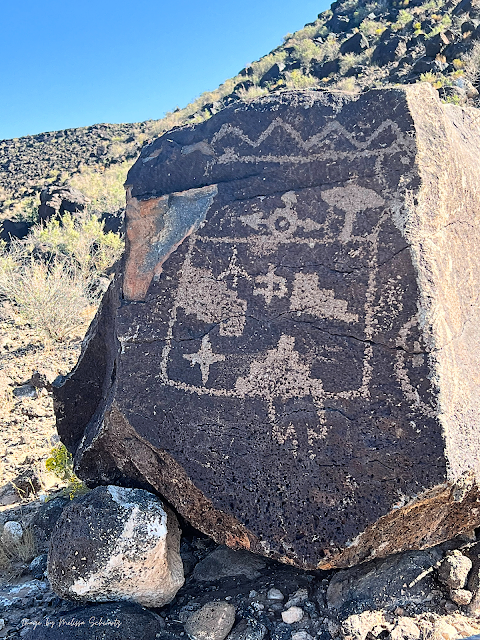 |
| Sun rays fall on a porous brownish-black boulder revealing petroglyphs. |
Today, there are 19 pueblos in New Mexico. The Contemporary Pueblo people of New Mexico are descendants of the Ancestral Pueblo who created the petroglyphs. Some of the petroglyph meanings have been interpreted by the Pueblo of today. However, defining the meanings of the petroglyphs to the public is not appropriate. Additionally, in some circumstances, the meaning of a petroglyph may differ from Pueblo to Pueblo.
The sacredness of the site: Honor the sacredness of Petroglyph National Monument to the Pueblo by not damaging the petroglyphs, staying on the trails, not removing anything from the park, not touching the rocks and boulders, and being respectful during your visit. Absolutely do not touch the petroglyphs -- the damage from the oil of your hands may be significant -- and do not create your own.
 |
| Basalt boulders create a volcanic landscape at Petroglyph National Monument. |
Hiking along the Boca Negra Canyon Mesa Point Trail, we did gain some elevation hiking up a slope of basalt boulders created by volcanic forces. Winding up the dusty, rocky trail, we spotted a number of petroglyphs. I noted during our brief time there how the petroglyphs were impacted by the sun. Differing positions of the sun reveal different petroglyphs. Additionally, the positioning of the sun and its intensity appeared to unveil changes in color. The petroglyphs were carved into the rocks between 400 and 700 years ago by the Ancestral Pueblo and the Spaniards.
 |
| Petroglyphs can be observed on a variety of rock faces. Different ones pop up as the sun's position changes. |
Descending up the trail through boulders, we noted splendid views of the surrounding volcanoes and mountains as well as Albuquerque. Of course, one of the best views can be experienced at the top.
 |
| Splendid view of the Sandia Mountains rising from above the lava rocks at Petroglyph National Monument on a beautiful sunny day. |
On top, we also spotted another indication of past human presence at the site in addition to the petroglyphs -- stacked rocks. The stacked rocks offer further evidence of human presence at the site. Ancestral Pueblo likely created hunting blinds and temporary shelters by stacking rocks. Additionally, they may have created structures for religious purposes. The Spaniards may have used the structures for animal pens.
 |
| Stacked rocks are another indication of human transformation of the site. |
There are other, shorter trails near the Mesa Point Trail. You may either walk to them from the parking lot or access them from a second lot. While both trails were fairly easy to navigate, one was a bit rockier with more elevation gained.
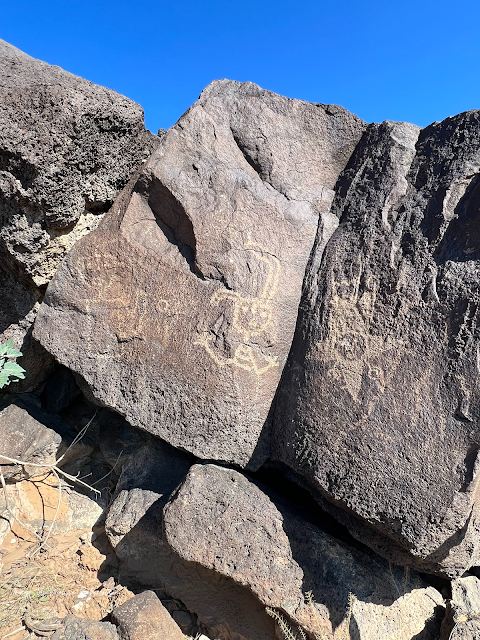 |
| The petroglyphs were carved into basalt boulders between 400 and 700 years ago. |
During our hikes, we also enjoyed spotting some of the indigenous flora and fauna including whiptails, the Greater roadrunner, broom snakeweed, and moonflowers.
 |
| A lizard trail likely from a whiptail along one of the Boca Negra Canyon trails. |
Rattlesnake Safety -- The Western Diamondback as well as Prairie Rattlesnake can be found in the preserve. Remember to stay on the trail and don't venture into areas that you cannot see behind where a rattlesnake could be hiding. Do not wear sandals or open-toed shoes. Keep an eye out at all times. Before you visit, learn about rattlesnake safety.
Hiking the Piedras Marcadas Canyon Trail
Along the Piedras Marcadas Canyon Trail, hikers may observe 400 or more petroglyphs. The trail is about 1.8 miles and back. If you add the North Rim Trail, the entire experience is about 2.8 miles. However, the petroglyphs are along the 1.8 mile viewing trail and not the North Rim Trail.
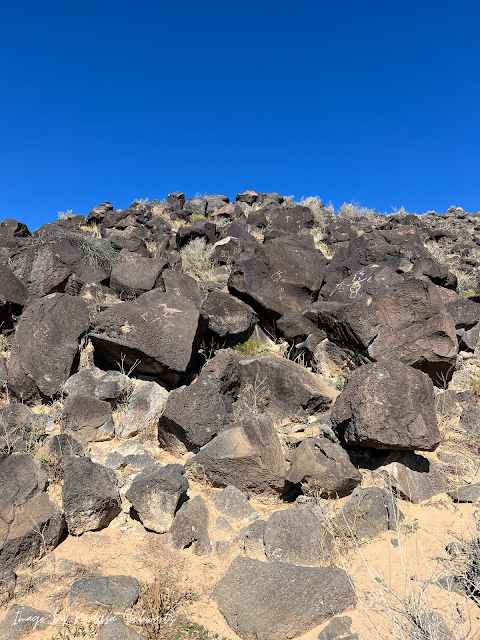 |
Petroglyphs carved into basalt boulders along the Piedras Marcadas Canyon Trail |
Overall, the hike was fairly easy along a sandy trail. Just as on the Boca Negra Canyon Trails, you will be in a desert environment. Be sure to bring water and a hat as well as wear sunscreen. Throughout this trail, I spotted a number of lizards most of which I believe were whiptails. I will need to brush up more on my New Mexico lizards before a return trip!
Petroglyphs appear throughout most of this trail. However, the direction of the sun and your own position may reveal different petroglyphs at different points of the day. Since this trail is a flatter trail, it was pretty interesting to see the petroglyphs in rise above you in a way.
On this trail, we also did see a Greater roadrunner. Really awesome!!! We felt both the Boca Negra Canyon trails and the Piedras Marcadas Canyon Trail offered fascinating trails for Albuquerque hiking.
 |
| Greater roadrunner at Petroglyph National Monument. |
Note about the Piedras Marcadas Canyon Trail: You will find the parking lot behind the Valvoline Motor Oil Store.
Volcanoes
Ancient volcanic eruptions from volcanic cones created the landscape. You will note lava rocks while hiking through Petroglyph National Monument. The porosity of some of the rocks was created as gasses escaped the lava while it cooled. The petroglyphs have been cut into the basalt rocks created by the volcanoes. Other volcanic formations are found within the park including cones themselves. We did not have a chance to visit, but the Volcanoes Day Use Area would be a great adventure to learn about the volcanic cones.
For more information on hours and visiting, check the National Park Service website.
Appreciation for Petroglyph National Monument
Petroglyph National Monument provides a culturally and ecologically rich outdoor exploration in Albuquerque. Cultural sites like Petroglyph National Monument are nonrenewable so it is important to preserve the sacred symbols and structures within the preserve. Preservation of Petroglyph National Monument is important to the Indigenous and maintains a cultural richness to our heritage and history.
We appreciated the ability to respectfully observe this sacred site. If we all work towards maintaining sites like Petroglyph National Monument, we will be able to keep these rich elements of the fabric of history available for future generations.

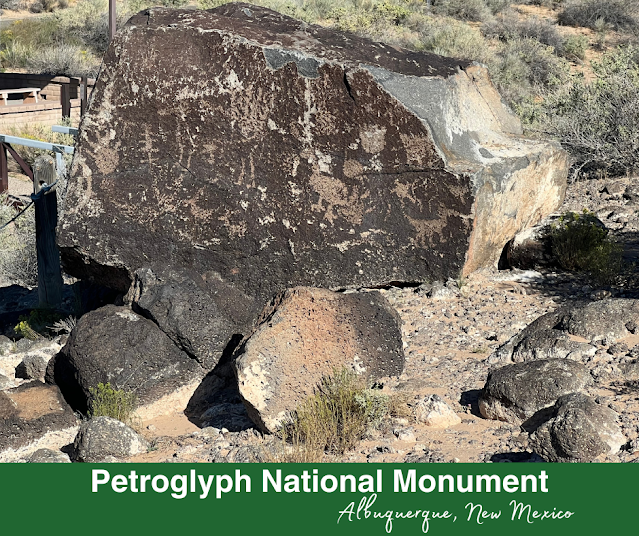

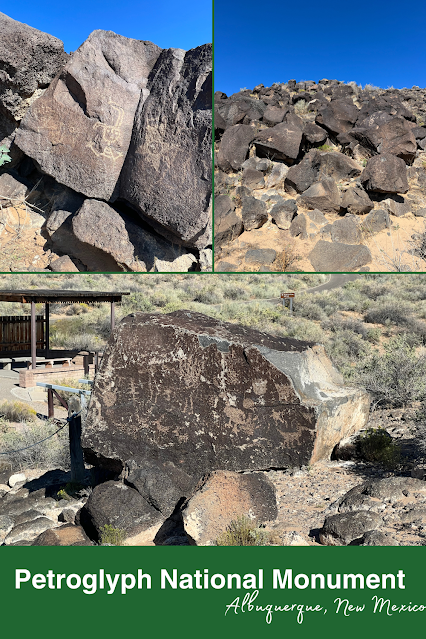
Post a Comment